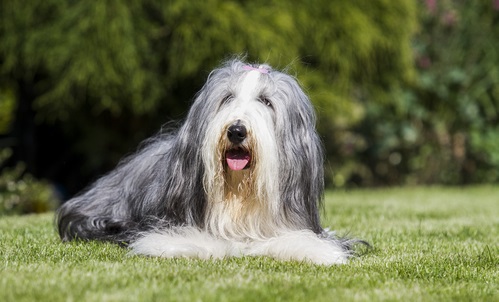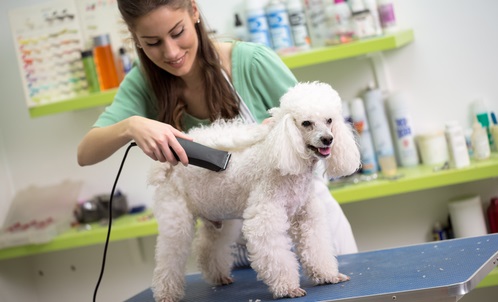Fur, fuzz, and fluff: a dog’s coat is more than just part of his looks and personality, it’s actually part of an intricate biological cooling system that helps him beat the heat, keeps pests at bay, and even avoid sunburn. In some cases, however, he could use a hand from his pet parents to help keep his magnificent mane under control – knowing when and how to shave a dog’s fur, however, is not a one-size-fits-all approach.
Considerations such as breed, environment, and even season affect the best grooming practices for his coat: sometimes a shave can help, but there’s a larger chance that a close shave will actually end up being harmful. Here’s how to ensure he’s getting what his fur really needs – no less, no more.
Avoid Actual Shaving
A periodic dog wash, groom, and trim is normal and healthy for many breeds and ensures their coat stays looking attractive and low-shedding. Actual down-to-the-skin shaving, however, is harmful and should be avoided – in fact, some dog lovers go as far to say that reputable groomers would refuse to trim that short. Professional canine associations like the American Kennel Club (AKC) recommend that a dog’s fur should never be trimmed shorter than an inch long, for both safety and comfort reasons. A shaved dog loses his protection from the outside environment, which can be damaging to his skin and cause other issues to arise.
Shaved fur can expose a dog’s skin, normally protected by fur, to the sun. This can lead to painful or harmful sunburns, particularly for dogs that spend a lot of time outdoors. Be aware that shaving your dog can risk the following outcomes:

- Shaved fur can interfere with a dog’s natural ability to keep himself cool in hot weather
- Shaved fur can also expose a dog to parasites or insects (e.g., mosquitos, ticks and fleas) that his coat might otherwise protect against
- Shaved fur can, in some aquatic-oriented dogs like Chesapeake Bay retrievers, damage the natural buoyancy or oiliness of their coat quality, leading to dangerous swimming problems
- And finally, shaved fur can affect the way his coat grows back in and fills out over time; when both the coats are shaved back at once, the undercoat can sometimes grow back too quickly, making him look patchy and unattractive
Double-Coated Breeds and Shaving
Compassionate double-coated dog breed owners know that a human wouldn’t wear a heavy fur coat on a hot summer day, which is why they often make a beeline for the groomers. Logic would dictate that removing what looks to be a hot, heavy coat of fur would help dogs like golden retrievers, huskies, and malamutes stay comfortable in the heat. Consider, however, that these breeds (or their similarly-built ancestor canines) existed long before groomers did, and they still managed to stay comfortable. His fur is built to insulate, and that goes for both heating and cooling – a properly-kept natural coat works like an umbrella would in the sun.

Shaving these types of double coats would be like taking the insulation out of a house: it’s much easier to hold in cool, comfortable air if the insulation remains in place. Additionally, because the skin beneath the fur seldom sees daylight under two coats, this pale skin is very susceptible to sunburn, and even canine skin cancer if exposed for long enough. Instead of shaving, try at-home grooming practices on a regular basis. Daily brushing will not only keep shed fur off the furniture and carpet, it will also help him bond with his pet parents. Removing this shed fur and stimulating the longer coat hairs – the “guard hairs” – with brushing will keep his coat looking lush, sleek, and healthy as well.
Pro Tip: Try a special grooming tool called an undercoat rake for removing large portions of shed under-fur with every stroke, rather than relying on brushing or combing it out alone. For the best (and cleanest) results, brush him outside so his fur can blow away or be repurposed into birds’ nest lining.
Tips For At-Home Grooming
While a professional groomer is typically the best choice for any necessary canine trims, for various reasons, some pet parents prefer to take care of it at home. Some dogs are too nervous or anxious to behave at the groomer’s, or there may not be a groomer close by; thankfully, the DIY dog grooming approach is usually very easy for both humans and their canine companions. Here are a few pointers for grooming your furry companion at home:
- Introduce him to grooming tools in a controlled environment: Many pet parents have found out the hard way that the whine of the buzzer sends their dog bolting out of their hands. Allow him to see, sniff, and inspect the tools being used on him, where he can’t twist free and run off at the first unfamiliar sight, smell, or sound. Gradual introduction is the name of the game, here.
- Make grooming a pleasant experience for him: Even though it’s tempting to just hold his collar firmly and “get through it,” remember that what a pet parent may feel like is “determination” can feel more like trauma to a frightened dog. Offer frequent praise, distracting treats or toys, and lots of petting throughout.
- Make it a team effort, whenever possible: Even small breeds can turn into virtual tornadoes of energy and legs if they decide they don’t want a haircut. Invite a fellow pet parent to help hold and position him in order to get an even cut; this also comes in handy for paw-holding during a nail trim. In addition to physically holding and moving him around, an added human presence can help settle a dog’s nerves, which makes for a better grooming experience all around.
- Mind the temperature of electric clippers: Motorized clipping tools and shavers can heat up quickly – after all, they’re typically made to shave a human head of hair, not the body of an entire dog. Make sure to trim a few minutes at a time, giving the clippers a few minutes to rest in-between as you brush out cut and shed fur. Hot metal clipper edges can pose a burn hazard for both a dog and his pet parent.
When Shaving A Dog Is Okay
Occasionally, a shave – or, more accurately, a very close cut – is needed to preserve a dog’s health and well-being. So when considering the question “Can I shave my dog?” the best answer tends to be it depends. These four occasions are the most clear-cut (pun intended) scenarios for a closer-than-usual canine cut:

1) One of the most common instances where shaving a dog is not only allowed, but encouraged, is prior to surgery. A vet will typically shave the area due to be operated on in order to avoid getting fur in the wound that could potentially cause a canine bacterial infection. Shaving this area ensures that the vet has a clear view of both the inside and outside of the operation site as well, giving them better visual acuity and accuracy during the procedure, and after, when applying stitches.
2) Another instance where a close cut works well is during what groomers call hygiene cuts. This is the area around a dog’s genitals and anus, and groomers will often cut the fur in this area back more aggressively than the rest of the dog’s body. Keeping long or curly hair away from these areas ensures that he can urinate and defecate without worrying that waste, liquid, or residue will end up tangled in the fur, causing skin and hygiene issues, as well as considerable unpleasantness for his human companions and their carpeting.
3) If a dog has a severe skin parasite or fungal infection, a vet may recommend shaving in order to keep the infection from growing and thriving, or to reliably access the problem area for topical treatment. This action should not, however, be taken lightly, and should ideally be done by a professional groomer to avoid accidental injury to the dog.
4) Finally, a dog may be shaved if his fur is matted due to a bad living situation; this scenario is common among rescue dogs and strays. For severely neglected dogs with long, hopelessly tangled planks of fur called mats, shaving is the only option. These dogs have large, painful mats that are often filthy and pull painfully at the skin with each movement the dog makes. In cases of fur mats on dogs, cutting off the mats becomes the lesser of two evils, providing him with significant physical and hygiene relief in exchange for a need to stay out of direct sunlight or bug-filled forests for a while.
In general, shaving should be avoided unless a dog’s health or grooming concerns fall into one of these four categories. Keeping his fur longer (yet brushed frequently) will help him properly regulate body temperature, stay protected from exposure and bugs, and stay looking like the handsome pup he is, inside and out.
Want to keep your furry friend calm when grooming? Canna Pet offers CBD pet treats, capsules and hemp oil to help your pet stay calm and relaxed. Check it out today!
Sources Cited:
- “Should You Shave Your Pet for Summer?” FETCH by WebMD (pets.webmd.com), (no published date), https://pets.webmd.com/features/shaving-dog-or-cat-during-summer#2. Accessed September 5, 2020.
- “Heat Wave Approaching! Should You Shave Your Pet?” ASPCA.org, July 14, 2017, https://www.aspca.org/news/heat-wave-approaching-should-you-shave-your-pet. Accessed September 5, 2020.
- Haynes, Shireen. “Why Shaving Your Double-coated Dog Is Not Your Best Idea.” Verona Street Animal Society (vsas.org), July 5, 2017, https://vsas.org/2017/07/why-shaving-your-double-coated-dog-is-not-your-best-idea/. Accessed September 5, 2020.
- Meyers, Harriet. “Is It Ok to Shave Your Dog’s Coat?” American Kennel Club (akc.org), June 10, 2020, https://www.akc.org/expert-advice/health/is-it-ok-to-shave-your-dog/. Accessed September 5, 2020.




